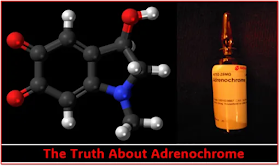However, Adrenochrome is a potent drug that has diverse effects on the body and mind and can even cause sudden death.
There is a recognised association between rising to the top in many professions and psychopathic or sociopathic tendencies and while some individuals may naturally possess these traits, others might turn to chemical assistance, such as adrenochrome, to achieve similar effects, according to biomedical scientist, Simon Lee, who claims that, Adrenochrome can enable these individuals to feel disinterested and superior and where causing others to suffer may ordinarily disturb them the drug helps them to navigate without emotional disturbance, maintaining a belief in their mental clarity.
“One of the most ludicrous arguments proffered by the mainstream media, meant to “debunk” the adrenochrome allegations, is that “adrenochrome is a relatively mundane chemical compound created by oxidizing adrenaline.” Therefore, mainstream media reporters argue, there is no reason for suspected “élite” adrenochrome junkies to drink child blood.”
Contrary to the propaganda, adrenochrome is not a drug “drummed up by a semi-fictional memoir” it is a real drug that has been the subject of a significant amount of peer reviewed scientific research.
Propagandist Jennifer Walker-Journey claims to be “Untangling the Conspiracy Theories Around Adrenochrome” in HowStuffWorks with lies such as this:
“In truth, adrenochrome is a rather innocuous chemical compound produced by the oxidation of the body’s stress hormone adrenaline, also called epinephrine.”
In actual truth, a wide range of physiological activity has been ascribed to adrenochrome and closely related substances. Many claims and counterclaims have been made, thereby stimulating interest in its physical and chemical properties. This has resulted in a “considerable volume of literature on the physiological and pharmacological properties of adrenochrome and related compounds.” according to Dr A. Hoffer.
A red oxidation product of adrenaline was isolated in crystalline form from the products of an enzymatic oxidation and identified by Green and Richter in 1937, who proposed the name “adrenochrome”. When these crystals are crushed, the resulting powder is bright red in colour.
Although pure adrenochrome is relatively stable in the solid state, its aqueous solutions, decompose rapidly with the formation of black precipitates of melanin.
Adrenochrome is a chemically very reactive substance, and it reacts with a wide variety of bodily constituents. It clearly interferes with sensory perception suggesting that the brain is the main target.
Research interest in adrenochrome has been shown in the fields of neurology, cardiology, and psychiatry.
The research in cardiology shows that adrenalin is very readily oxidized into adrenochrome which is toxic to myocardial tissue and may be responsible for fibrillation and sudden death under stress. Myocardial tissue is very high in the enzyme which oxidises adrenalin to adrenochrome.
Cocaine blocks two of the enzyme systems the body normally uses to destroy adrenalin, thereby forcing more of it into the adrenochrome pathway. This could be the explanation for sudden death sometimes associated with cocaine abuse.
Adrenochrome interferes with the growth and function of intact cells. It inhibits respiratory reactions, glycolysis, and cell division (mitosis).
Adrenochrome inhibits decarboxylation of the neurotransmitter glutamic acid in brain tissue, oxidises simple amino acids, is an antagonist of the neurotransmitter serotonin, can inhibit synaptic transmission, and it is polymerised to brownish melanin pigments in brain, intestinal mucosa, and skin.
When adrenochrome is added to living neurons:
“The normal neurons pulsated slowly and rhythmically. When a small quantity of adrenochrome was added to the culture the cells began to pulsate more quickly and vigorously. Each cell appeared to develop contortions or convulsions in slow motion. After some time, the neurons rounded up in a spherical structure. Then the membrane must have ruptured for the cell disappeared leaving a spherical ring of dark fragments and pigmented material. LSD and serotonin also influenced pulsatile behaviour but did not kill the cells (Geiger, 1960). Schizophrenic serum was also toxic.”...<<<Read More>>>...
